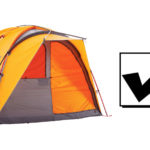With hundreds of tents on the market today, selecting a tent is no easy feat, and finding one that best meets your needs means learning a lot of new information about what makes a “good” tent and which tent is the right one for you.
One of the primary factors when considering what tent to get is the material of the tent itself as well as the tent poles. What are tents made of? Nylon, polyester, or canvas. Each tent material comes with its advantages and disadvantages. You’ll want to select a material compatible with the activity you plan to use your tent for.
For example, if you want a tent to take on overnight backpacking trips, weight might be your top concern, whereas you may want more durability if you’re setting up a tent year-round in your backyard.
Below we’ll compare the advantages and disadvantages of some common materials used in making modern tents and tent poles so you can feel confident about what type of tent will best meet your needs.
More...

Table of Contents
Nylon Tents
Nylon is one of the most popular materials used in modern tent manufacturing because of its light weight, water resistance, and durability.
Nylon is a synthetic material made of plastic used to produce a wide variety of products. Tents are most commonly made with nylon and polyester, but nylon is particularly popular amongst those designed for backpacking use.
If you’re suspicious of nylon’s durability, consider how commonly it’s used to make products. Everything from toothbrush bristles to activewear is made with nylon, and the fabric is composed of tiny strands of plastic weaved together.
While nylon is water-resistant by nature, it’s recommended that you purchase a tent that has been treated with silicone or polyurethane (PU) to ensure any additional moisture stays out.
If you’re only planning on camping in the summer, you may be able to get away with a non-treated tent, but if there’s a chance you’ll get caught in the rain, waterproofing is essential.
Continue below to learn some of the advantages and disadvantages of purchasing a tent made with nylon.
Advantages of Nylon Tents
Nylon tents come with a host of advantages. Consider these advantages against the disadvantages of nylon when deciding whether it’s a suitable tent fabric for you.
Nylon is exceptionally durable. One of the reasons it’s so popular for tent manufacturing is because it holds up so well to abrasion, an important consideration when using a product that will be rubbing against twigs, rocks, and other rough materials.
Nylon is not highly flammable, meaning it is more likely to melt if exposed to flames than alight.
Nylon is water-resistant, meaning it will keep out small amounts of moisture and dew.
Nylon fabric has good give, an important quality for tents so that you can pull the fabric taught.
Nylon tents are some of the most lightweight tents, ideal for backcountry camping and backpacking when weight is more of a consideration.
Disadvantages of Nylon Tents
While there are numerous advantages to nylon tents, there are disadvantages to tents made with this material as well.
Nylon is not waterproof, which means that you have to spend more for fabric that has been treated with PU or silicone.
Nylon tents have relatively no insulation and tend to be the thinnest fabric used in tent manufacturing.
Nylon tents tend to be more expensive, especially if they’re waterproofed.
The elasticity of the fabric can lead to eventual sagging as the fabric loses its stretchiness over time, particularly if it gets weighted down by rain or debris.
Now that you’re familiar with nylon tents let’s look at how tents made with polyester compare.
Polyester Tents
While tents are commonly made with nylon, another common tent material is polyester. Polyester is typically a more affordable option than nylon, so you’ll tend to see this material used on less expensive models.
Polyester is another synthetic material made by creating a chemical reaction when water, petroleum, and air come into contact with one another. This fabric is strong and reliable, so it’s commonly used for outdoor recreational clothing and accessories.
Because of its widespread use and relative affordability, polyester is one of the most commonly used synthetic fabrics worldwide.
Below, we’ll discuss the advantages and disadvantages of polyester tents.
Advantages of Polyester Tents
Polyester tents tend to be nylon’s biggest competitor; consider these advantages and disadvantages of tents made with polyester as you decide which material will best meet your needs.
Polyester is significantly less expensive than nylon tents. So if the price is your primary consideration, you can get a lot of the same benefits from polyester tents for a fraction of the cost.
Like nylon, polyester is highly durable. It is resistant to tears and abrasions and holds up well against the rough terrain when camping.
Polyester is similarly moisture-resistant to nylon, meaning it will protect from mild condensation and moisture.
Disadvantages of Polyester Tents
Polyester has many advantages over a canvas tent or even a nylon tent, but it also has several disadvantages.
The fabric is bulky compared to nylon fabric. While nylon can be extremely thin and pack down small, polyester tents tend to have larger pack sizes.
Polyester sometimes has a " cheaper " feel than nylon tents because it’s not always as sleek and polished.
Polyester is heavy compared to nylon. But, again, polyester falls in the middle and is still lighter than canvas tents.
Like nylon, polyester doesn’t provide the best ventilation. With moisture resistance comes an inability to allow the moisture to escape.
Continue reading to learn about canvas tents and what they can offer you that nylon and polyester tents can’t.
Canvas Tents
Canvas tents are typically made with cotton but can be made with linen as well. Cotton tents are heavier duty and are commonly treated with a moisture-wicking coating like polyurethane when used in inclement weather.
Canvas tents are seldom used for camping tents anymore and tend to be used for large shelters; classic green army tents are made with canvas.
Canvas tents were largely phased out for outdoor recreational use because of how heavy they are, especially if they get wet.
However, canvas tents were used for a long time, and some vintage tents are still in existence today, which is a testament to their durability.
Continue reading to consider the advantages and disadvantages of purchasing a canvas tent.
Advantages of Canvas Tents
Although not widely made anymore, canvas tents haven’t completely lost their usefulness. Consider the following advantages to determine if a canvas tent would be right for you.
Canvas tents are incredibly durable. They tend to be heavyweight materials that can withstand wind and falling debris, protecting you from the elements.
They last seemingly forever. If you care for your canvas tent, it’s likely to be around as long as you are.
Unlike polyester and nylon tents, canvas tents are highly breathable. Because they aren’t naturally water-resistant, they provide good ventilation.
Disadvantages of Canvas Tents
While canvas tents can offer some advantages, nylon and polyester tents do not consider the following disadvantages of canvas tents before purchasing one.
Canvas tents are incredibly bulky. If you purchase a large canvas tent, plan to have a storage solution because they don’t pack down.
Canvas tents are heavy; it can often be a two-person job to set up a canvas tent because of how heavy the material is.
Because the material is heavy, the poles need to be heavier and sturdier, adding to the overall weight of the tent.
While canvas tents are comfortable and durable, they don’t really make sense for modern-day camping and backpacking because of how heavy and difficult to transport they are.
Common Tent Pole Materials
Now that you know what are tents made of, it’s important to understand what materials tent poles are made with and how this affects the overall construction and weight of the tent you purchase.
Aluminum Tent Poles
The majority of tents you see on the market today are likely to use aluminum tent poles. Aluminum is a lightweight, relatively affordable option and is typically paired with polyester and nylon tents designed for camping and backpacking.
Aluminum is an extremely strong material (although not as strong as carbon fiber), making it an excellent option if durability is your primary concern. In addition, this strength means that your tent is better equipped to handle wind, rain, and falling debris without being compromised.
Aluminum is a flexible metal, making it the most appealing option between itself, carbon fiber, and fiberglass. Flexibility is vital for ensuring your tent poles maintain their shape without breaking.
One thing to be aware of if you purchase a tent with aluminum poles is that you should always let your tent poles dry out before packing them away to avoid metal corrosion. However, this is the best practice for your tent to avoid mold and mildew buildup.
Carbon Fiber Tent Poles
Carbon fiber tent poles are typically used in high-end tents, and you’ll often see them paired with nylon tent fabric to cut down on weight. Carbon fiber is an organic polymer and is a less commonly used material for tent poles.
Carbon fiber is beneficial in the construction of your overall tent because it can keep weight low without sacrificing strength. In addition, carbon fiber is actually stronger than steel metal, at a fraction of the weight; it’s also stiffer than steel.
However, carbon fiber comes with a pretty substantial downside: when it does break, it can break in shards rather than snap evenly.
This can cause potential hazards for you if you cut yourself on the material, or it has the potential to rip your gear if it comes into contact with your tent when it breaks.
Carbon fiber isn’t significantly lighter than lightweight aluminum, and unless a tent you love comes with these tent poles, there would be no need to seek them out.
Fiberglass Tent Poles
The last commonly used material in the construction of modern tentpoles is fiberglass. Unfortunately, fiberglass tent poles are much heavier than aluminum and are not as strong. For this reason, they are more commonly used in less expensive tents designed for car camping rather than backpacking.
A major consideration with fiberglass tent poles is how brittle this metal is. Not nearly as flexible as aluminum, be careful to overextend your fiberglass tent poles, or they may simply break.
This is especially true in colder weather, which is why you seldom see this type of tent pole used in four-season tents.
Steel Tent Poles
Steel is rarely used for tent poles anymore due to its weight, but you may see steel tent poles with canvas tents to bear the weight.

Key Takeaways
Purchasing a tent is an important decision, especially if you plan to spend a lot of your time camping or backpacking. Educating yourself on tent fabrics and pole materials is an essential part of making an informed decision on which tent is right for you.
Nylon
Nylon tents are ideal for those who plan to do a lot of backpacking. Their light weight and moisture resistance make them ideal for trekking up to high elevations. However, you should consider getting one that is moisture-treated if you plan to camp in the rain at all.
Polyester
Polyester is perfect if you plan on doing a lot of car camping. Polyester tents are less expensive than nylon tents, and if you don’t need to pack your tent into a backpack, the added weight and bulk likely won’t bother you.
Canvas
Canvas tents are better suited for individuals looking to set up a tent long-term. They are heavy and difficult to set up and store. However, they offer good airflow, and you can choose to moisture treat them if you wish.
Final Thoughts
Now you know what are tents made of. We hope this guide helped teach you the key differences between standard tent fabric and tent pole materials. When purchasing a tent, it’s essential to think about what you plan to use it for. If you know you’re going to be car camping, there’s no need to spend additional money purchasing an ultralight tent. However, if backpacking is your primary outdoor activity, being aware of which materials are the lightest is essential in choosing a tent that will best meet your needs.
- Are Merrell Shoes Good? – An Unbiased Review of Merrell Footwear - December 9, 2023
- Where Are Merrell Shoes Made? - December 9, 2023
- Camping in 40-degree Weather: Tips and Tricks - September 25, 2023



![10 Best Budget Backpacking Tents Under $100 [Buyers Guide] 10 Best Budget Backpacking Tents Under $100 [Buyers Guide]](https://grandcircletrails.com/wp-content/uploads/2022/02/Budget-Backpacking-Tents-Under-100-1-150x150.jpg)


![How to Dry Tent after Rain? – 2 Proven Methods [Explained] How to Dry Tent after Rain? – 2 Proven Methods [Explained]](https://grandcircletrails.com/wp-content/uploads/2021/08/How-to-Dry-Tent-after-Rain-1-150x150.jpg)